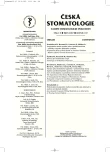Low-viscosity Composite Filling Materials as an Alternative in Treating Cervical Defects
Nízkoviskózní kompozitní výplňové materiály jako alternativa ošetření cervikálních defektů
Autor v předkládané práci sleduje chování cervikálních výplní z nízkoviskózního kompozitního materiálu Tetric® Flow zhotovených v kombinaci s dvoufázovým samoleptacím adhezivním systémem AdheSE®. Ošetřené defekty byly jak původu kariézního, tak i původu nekariézního.
Do studie bylo zahrnuto celkem 29 pacientů, 10 mužů a 19 žen s cervikálními defekty kariézního i nekariézního původů. Celkem bylo u těchto pacientů v průběhu roku 2002 ošetřeno 79 cervikálních defektů, z toho 30 defektů kariézního původu a 49 defektů nekariézního původu. Výplně byly dále sledovány v ročních intervalech až do roku 2006.
Celková životnost výplní činila po uplynutí 4 let 86,7 % u defektů kariézního původu a 93,9 % u defektů nekariézního původu. Ostatní sledované parametry modifikovaných USPHS kritérií byly až na výjimky lepší u defektů nekariézního původu.
Nízkoviskózní kompozitní výplňové materiály se jeví jak velmi dobrá volba k ošetření cervikálních defektů.
Klíčová slova:
cervikální defekt kariézního původu (CCL) – cervikální defekty nekariézního původu (NCCL) – nízkoviskózní kompozitní materiál – modifikována USPHS kritéria
Authors:
A. Ellababidi
Authors‘ workplace:
Stomatologická klinika 3. LF UK a FNKV, Praha
přednostka doc. MUDr. E. Gojišová
Published in:
Česká stomatologie / Praktické zubní lékařství, ročník 107, 2007, 5, s. 130-134
Overview
The author in his present study focuses on the behavior of cervical fillings created using the lowviscosity composite filling material Tetric® Flow in combination with the 6th generation, no-mix, self-etching adhesive system AdheSE®. The treated defects were of both carious and non-carious origin.
The study was performed on the total number of 29 patients, 10 males and 19 females with both carious and non-carious cervical lesions. The total number of 79 cervical defects was treated during the year 2002. Thirty of those defects were of carious origin and 49 of non-carious origin. The fillings were then periodically observed once a year up to 2006.
The total survival rate of those fillings after 4 years was 86.7% in case of carious cervical lesions and 93.3% in case of non-carious cervical lesions. The rest of the observed modified USPHS criteria were, with two exceptions, significantly better in case of non-carious defects.
Low-viscosity composite filling materials seem to be a good choice in treating cervical defects.
Key words:
carious cervical lesions (CCL) – non-carious cervical lesions (NCCL) – low-viscosity composite filling material – modified USPHS criteria
Labels
Maxillofacial surgery Orthodontics Dental medicineArticle was published in
Czech Dental Journal

2007 Issue 5
- What Effect Can Be Expected from Limosilactobacillus reuteri in Mucositis and Peri-Implantitis?
- The Importance of Limosilactobacillus reuteri in Administration to Diabetics with Gingivitis
Most read in this issue
- Non-surgical Treatment of a Tooth Associated with a Large Periapical Radiolucency Resembling Periapical Cyst
- Anatomical Deviations of Endodontium as a Cause of Failure of Endodontic Treatment
- Anchorage in Orthodontic Treatment
- Corrosion of Dental Alloys
